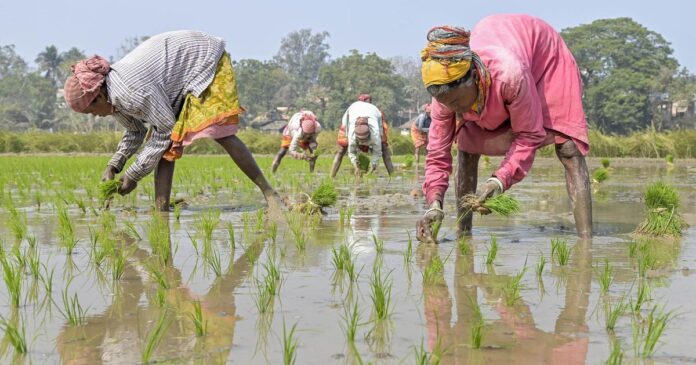Monsoon rainfall serves as the primary source of irrigation for a significant portion of India’s agricultural land

Manoj Kumar Pathak
The arrival of the monsoon season in India is much more than just a change in weather patterns. It heralds a period of rejuvenation and vitality for the country, impacting various facets of life ranging from agriculture to the economy as a whole. With the India Meteorological Department (IMD) predicting above-normal monsoon rainfall, the significance of this annual phenomenon cannot be overstated. In this article, we delve into why monsoon rainfall matters deeply to India, exploring its role in driving agricultural productivity, ensuring food security, and stabilizing the economy.
Monsoon rainfall serves as the primary source of irrigation for a significant portion of India’s agricultural land. Despite advancements in irrigation infrastructure, nearly half of the country’s net-sown area still relies solely on rainfall for water supply. This dependence underscores the critical importance of timely and adequate monsoon rains for farmers across the country.
Agriculture remains the backbone of India’s economy, employing a vast majority of its workforce and contributing significantly to its GDP. The monsoon season plays a pivotal role in determining agricultural output and, consequently, the livelihoods of millions of farmers and agricultural workers. A bountiful monsoon leads to increased soil moisture levels, facilitating optimal crop growth and higher yields. Conversely, a deficient monsoon can spell disaster, leading to crop failures, reduced incomes, and economic hardship for rural communities.
The impact of monsoon rainfall extends beyond the agricultural sector, reverberating throughout the economy and society at large. India’s food security hinges on the success of its agricultural endeavors, with a substantial portion of the population dependent on locally grown crops for sustenance. Staple crops such as rice, wheat, and pulses are heavily reliant on monsoon rains for their growth, making rainfall patterns a matter of national importance.
A robust monsoon season not only ensures an ample supply of food grains but also helps to stabilize food prices. Adequate agricultural production resulting from favorable monsoon conditions can mitigate the risk of food shortages and inflationary pressures. This, in turn, has a cascading effect on overall consumer sentiment and economic stability, as food prices directly impact household budgets and inflationary expectations.
The health of India’s economy is intricately linked to the performance of its agricultural sector, making monsoon rainfall a crucial determinant of economic growth and development. A successful monsoon season injects momentum into rural economies, stimulating demand for agricultural inputs, labor, and ancillary services. Increased farm incomes translate into higher rural purchasing power, driving consumption and spurring economic activity in rural areas.
Conversely, a deficient monsoon can have far-reaching consequences for the economy, dampening agricultural productivity, exacerbating rural distress, and impeding overall economic growth. Reduced agricultural output not only affects farmers’ incomes but also disrupts supply chains, leading to shortages and price volatility in the broader economy. Moreover, the ripple effects of a weak monsoon are felt across various sectors, including manufacturing, services, and trade, amplifying the economic downturn.
Given the critical importance of monsoon rainfall to India’s economy and livelihoods, policymakers must adopt a proactive approach to mitigate the risks associated with monsoon variability. Investments in water management infrastructure, including irrigation systems, rainwater harvesting, and watershed development, are essential to enhance the resilience of agricultural ecosystems and minimize the impact of erratic rainfall patterns.
Furthermore, diversification of agricultural practices, promotion of climate-smart technologies, and adoption of sustainable farming practices can help farmers adapt to changing climatic conditions and mitigate the adverse effects of monsoon variability. Additionally, strengthening social safety nets and providing targeted support to vulnerable communities can help cushion the impact of monsoon-related shocks, ensuring inclusive growth and equitable development.
The significance of monsoon rainfall to India’s economy and society cannot be overstated. As the lifeline of agricultural productivity, food security, and economic stability, the monsoon season plays a pivotal role in shaping the country’s developmental trajectory. The IMD’s prediction of above-normal monsoon rainfall offers a ray of hope for farmers and policymakers alike, signaling the potential for a boost to agricultural output, rural incomes, and overall economic growth.
However, it is imperative to recognize that the impact of the monsoon extends beyond mere statistics and economic indicators. It is intertwined with the lives and livelihoods of millions of people who depend on the land for their sustenance. Therefore, fostering sustainable water management practices, investing in resilient agricultural systems, and prioritizing the welfare of rural communities are essential for harnessing the full potential of the monsoon and ensuring a prosperous and inclusive future for India.
–************************************


